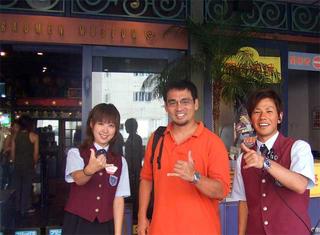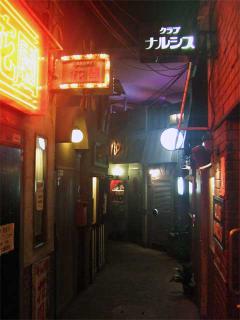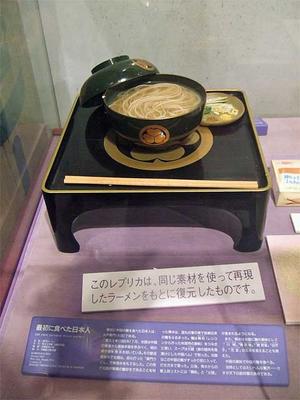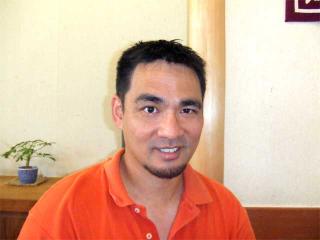Today was the day we had set for going home. I had done all of the research I needed to do. Now, Tokyo is a huge city, and there were many more things I wanted to do: visit Roppongi Hills, Shibuya, Shinjuku, the National Museum, Omotesando, Harajuku, more of Shiodome and Odaiba. But then, Tokyo was bleeding us dry of money, and I thought that it would be good for Yoko to be back with her family. We could always visit trendy places in Osaka. So we were packing our bags when it dawned upon me that there WAS one place that I really wanted to visit but had not the chance to go.
“I want to go to the Raumen Museum in Yokohama!”
Yes, Virginia, there really is a Raumen Museum, with a "u" in the word "ramen". It was only a ten-minute walk from the Yokohama Shinkansen (Bullet Train) station, and so it would be possible to stop by on our way home. I had heard about it since its’ opening in 2001 or so, and had always wanted to visit. For those of you who know little of modern Japan, ramen is considered a poor man’s gourmet food. Much like how there are wine aficionados, there are ramen otaku, who judge a ramen by its noodles, soup, meats, appearance, smell, and overall balance. The soup is like making wine: basic process is easy to learn, but to produce a harmonious, balanced product takes years, sometimes decades of trial and error. You can buy myriads of ramen guidebooks that rank ramen both regionally and nationally. True ramen otaku will travel far and wide in search of the perfect bowl of ramen because many of the owners refuse to franchise (although franchised branches of famous ramen shops are becoming more common). Some ramen fans will apprentice under hard working conditions in order to learn how to make a perfect bowl of ramen. Just recently a famous ramen chef had the Chinese mafia kidnap and beat up another famous ramen chef because he felt that the chef had stolen his secret recipe.
We caught a bus to the bullet train station, and then walked to the Ramen Museum. Admission is 300 yen, or almost three dollars, and there is a special repeat pass for true ramen fans. I took a photo with the staff at the museum entrance.

A brief note about the Raumen Museum is in order. It was created a few years ago by one of the premier chefs of ramen in order to educate the public about this gourmet food. Now the Raumen Museum has displays for the history of ramen, but their true selling point is that the master chef managed to convince the owners of some of the best and most famous ramen shops in Japan to open up shop in the museum. So the whole shop is a recreation of 1950s Yokohama, complete with public TV sets broadcasting pro wrestling, and even an alley of 1950s style bars. Eight of the famous ramen shops, along with a booth for an up and coming ramen shop were in replicas of 1950s shops. The ramen shops serve mini-ramen for those of us who want to sample as many of the different regional varieties of ramen as possible.

Why can’t someone in America realize that entertainment and shopping and dining go hand in hand? If I had the cash to build a shopping mall, I would make a recreation of 1950s Hawaii, and have real shops inside of the recreations of the 1950s buildings. I would play hapa haole 1950s Hawaiian music and of course, Elvis Presley to set the ambiance. Both tourists and locals would come. I would call this the Plate Lunch Museum.
Anyway, I went nuts eating ramen – visited FOUR different shops. Each ramen was superb and had its own characteristics. One was made from all chicken – the soup was made purely from chicken, and even char siu from chicken. Yoko and Reiko decided to snack and drink potato liquor (shochu) at an old-style street stall, so I continued my ramen adventures on my own. Another shop made ramen with lard as its key ingredient. Yes, lard blended into the noodles, and into the soup. It sounds gross, but the ramen did have a strong individual taste and I devoured it within minutes.

The third, Shina Soba, was the most famous of the ramen shops as it was the preserve of the master chef who originated the museum. I heard some customers at the previous place say that they were disappointed in the ramen, and that it was so ordinary. When I ate it, I detected nothing special and was disappointed at first. But little did I realize it when I ate the whole bowl of ramen in the blink of an eye. The ramen was so well balanced that the balance itself was its characteristic. There was no salty aftertaste. This is not a ramen that hits you with a right hook. No, this is balanced ramen that can be mistaken for blandness by an inexperienced tongue. Last of all, we all had miso ramen at a restaurant originally from Sapporo.
Upstairs, I visited the recreation of a bar district and saw all sorts of old buildings. I felt like I was back in 1950s Japan, and I wasn`t even born then! It looked like all those magazines and old TV shows I saw.
 I even saw a huge display in the museum area that showed the evolution of ramen, and had a huge display of all the instant ramen. Upstairs was a Naruto (a popular anime series) shop, and the customers were all foreigners speaking English. So that is how you get otaku tourist dollars...
I even saw a huge display in the museum area that showed the evolution of ramen, and had a huge display of all the instant ramen. Upstairs was a Naruto (a popular anime series) shop, and the customers were all foreigners speaking English. So that is how you get otaku tourist dollars... 
We had to go back to Osaka so that was the end of the day. I found out that the shop I did not go to, Aokiya, was the shop involved in the ramen kidnap and Chinese mafia case. Oh well, I will eat it the next time I go to Yokohama.
Anyway, we got our JR rail passes at Yokohama station, which meant we could travel all we want on the bullet train for a week for only $280 each! The staff woman helped us out when we forgot to bring our passports. Yoko called her sister, who opened our passports left at home, and we got our passport numbers. So remember to bring your passports when you turn in your rail passes.


No comments:
Post a Comment